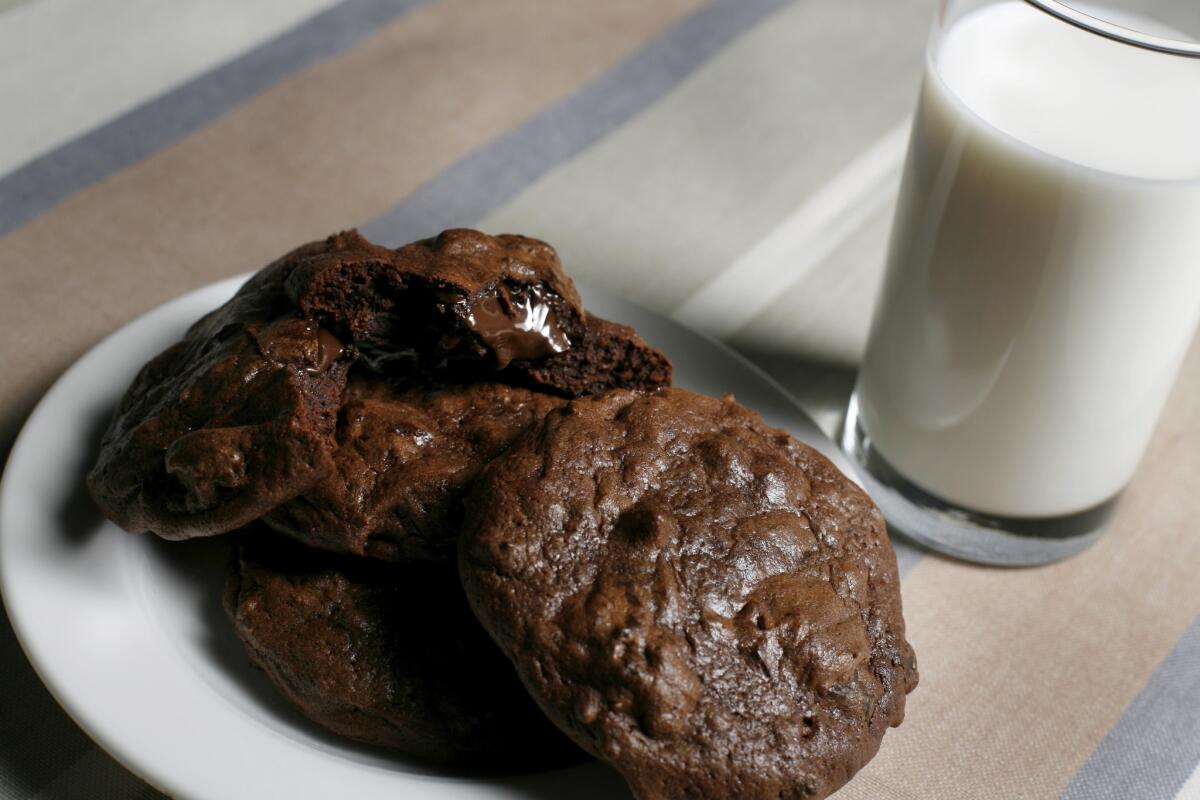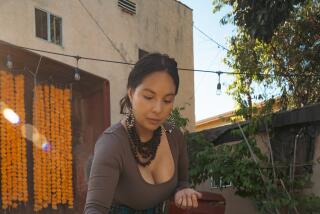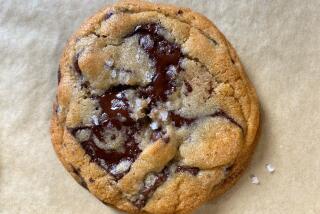Test Kitchen tip: Natural vs. Dutch-process cocoa powder ... and a recipe

- Share via
Like chocolate, cocoa powder is made from cacao beans. After the beans are processed into a paste known as chocolate liqueur, some of the cocoa butter is removed and the remaining solids are pulverized into a powder.
Standard “natural” (or non-alkalized) cocoa powder is typically sold unsweetened, and although it may taste rather bitter and harsh on its own, its natural acidity works with baking soda to help leaven baked goods, giving a finished dish a balanced chocolate flavor.
Cocoa powder is often treated with an alkali to make what is known as Dutch-process or alkalized cocoa. The alkali helps neutralize the natural acidity of the powder, giving the cocoa a more mellow and smooth, less bitter flavor.
Because of this, Dutch-process cocoa is often preferred when “dusting” or garnishing a finished cake or desserts; in baking, it’s used in recipes that call primarily for baking powder as a leavener. It can also have a richer, deeper color than natural cocoa.
When baking, keep in mind that natural and Dutch-process cocoa powders are not always interchangeable -- blindly substituting one for the other can upset the delicate chemical balance in a recipe, spoiling results and flavor (you don’t want your chocolate cake to taste like it was made with soap). Sometimes one cocoa powder can be substituted for the other in recipes. According to “The King Arthur Flour Baker’s Companion”:
“If a recipe calls for natural cocoa and baking soda and you want to use Dutch-process cocoa, substitute an equal amount of Dutch-process cocoa but replace the soda with twice the amount of baking powder. If the recipe calls for Dutch-process cocoa powder and baking powder, substitute the same amount of natural cocoa but replace the baking powder with half the amount of baking soda.”
Cooking is fun — at least it should be! No matter how long you’ve been in the kitchen, there is always something new to learn, whether it’s a simple twist on an old technique, or a handy tip to save time and energy. In this series of short videos, I demonstrate a variety of kitchen tips, including how to hold a chef’s knife for maximum control and how to use a spoon to peel fresh ginger. If you have any gadgets, kitchen tips or questions you’d like me to explore, leave a comment or shoot me an email at noelle.carter@latimes.
MILK’S OOEY-GOOEY DOUBLE-CHOCOLATE COOKIES
Total time: 40 minutes, plus 1 hour chilling time for the batter | Makes 1 1/2 dozen
Note: Adapted from Bret Thompson of Milk in Los Angeles
1/4 pound (4 ounces) unsweetened chocolate
4 tablespoons ( 1/2 stick) butter
3 eggs
2 teaspoons vanilla extract
1 cup sugar
1/2 cup flour
2 tablespoons Dutch-process cocoa powder
1/2 teaspoon baking powder
1/2 teaspoon salt
1 pound bittersweet chocolate (chunks or chips)
1. In a bowl set over a pot of simmering water, melt the unsweetened chocolate and butter. Remove from the heat and cool slightly.
2. In the bowl of a mixer with a paddle attachment, or in a large bowl using a fork, combine the eggs, vanilla and sugar. Mix just until incorporated and set aside.
3. Sift together the flour, cocoa powder, baking powder and salt into a medium bowl. Set aside.
4. Add the melted chocolate to the egg mixture and mix just until combined. Stir in the sifted dry ingredients and mix just until combined, then stir in the bittersweet chocolate.
5. Cover the batter with plastic wrap and refrigerate for at least 1 hour to chill thoroughly. Heat the oven to 350 degrees.
6. Divide the dough into 18 portions. Grease your hands (to prevent the dough from sticking) and shape the portions into balls. Place the balls on a greased, parchment-lined sheet pan, leaving 2 to 3 inches between each.
7. Bake until the edges of the cookies are just set and the center is still soft, 10 to 12 minutes, rotating the pan halfway through. Place the cookies, still on the parchment, on a rack and cool completely before serving. They will be very soft.
Each cookie: 251 calories; 4 grams protein; 29 grams carbohydrates; 3 grams fiber; 18 grams fat; 9 grams saturated fat; 42 mg. cholesterol; 92 mg. sodium.
Love cooking as much as I do? Follow me @noellecarter on Twitter.
More to Read
Eat your way across L.A.
Get our weekly Tasting Notes newsletter for reviews, news and more.
You may occasionally receive promotional content from the Los Angeles Times.











